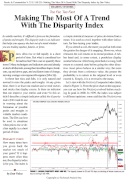Stocks & Commodities V. 27:12 (18-25): Making The Most Of A Trend With The Disparity Index by Dan Valcu
Product Description
Making The Most Of A Trend With The Disparity Index by Dan Valcu
In volatile markets, itís difficult to forecast the formation of peaks and troughs. The disparity index is an indicator that helps you squeeze the best out of a trend whether you are trading equities, futures, or forex.
Prices often rise or fall rapidly in a short period of time. But what is considered too far and too fast? How can we quantify these terms? Many techniques and indicators are used already to deal with this task, among them trendline slopes, breakouts, up and down gaps, and oscillators (rate of change, moving average convergence/divergence [Macd]).
In these fast rises and falls, it is only natural and normal to miss the peaks and troughs. At any given time, there is at least one market and several sectors and stocks that display excess. Is there an indicator that can improve your entries and exits? In this article I describe a simple indicator called the disparity index (Dix) and its use in warning about the formation of possible peaks and troughs in volatile market conditions. The Dix can best be used in situations when prices rise or decline rapidly in a short period of time.
DISPARITY INDEX
How many times have you given back the market too much of your gains? If it happens more often than not, the disparity index is for you. The index is a simple statistical measure of price deviation from a mean. It is used as a tool, together with other indicators, for fine-tuning your trades.
If you stretch a coil, the more you pull at both ends the greater the danger of it snapping. However, when released, the coil returns to its initial position. A rubber band and, to some extent, a pendulum display similar behavior. After being stretched or swung, both return to a neutral state before going the other direction. Asset prices behave in a similar way; the more they deviate from a reference value, the greater the probability is to return to the original level or even exceed it. Simply, it is a reversal to the mean.
In volatile markets, itís difficult to forecast the formation of peaks and troughs. The disparity index is an indicator that helps you squeeze the best out of a trend whether you are trading equities, futures, or forex.
Prices often rise or fall rapidly in a short period of time. But what is considered too far and too fast? How can we quantify these terms? Many techniques and indicators are used already to deal with this task, among them trendline slopes, breakouts, up and down gaps, and oscillators (rate of change, moving average convergence/divergence [Macd]).
In these fast rises and falls, it is only natural and normal to miss the peaks and troughs. At any given time, there is at least one market and several sectors and stocks that display excess. Is there an indicator that can improve your entries and exits? In this article I describe a simple indicator called the disparity index (Dix) and its use in warning about the formation of possible peaks and troughs in volatile market conditions. The Dix can best be used in situations when prices rise or decline rapidly in a short period of time.
DISPARITY INDEX
How many times have you given back the market too much of your gains? If it happens more often than not, the disparity index is for you. The index is a simple statistical measure of price deviation from a mean. It is used as a tool, together with other indicators, for fine-tuning your trades.
If you stretch a coil, the more you pull at both ends the greater the danger of it snapping. However, when released, the coil returns to its initial position. A rubber band and, to some extent, a pendulum display similar behavior. After being stretched or swung, both return to a neutral state before going the other direction. Asset prices behave in a similar way; the more they deviate from a reference value, the greater the probability is to return to the original level or even exceed it. Simply, it is a reversal to the mean.
FOR THOSE ORDERING ARTICLES SEPARATELY:
*Note: $2.95-$5.95 Articles are in PDF format only. No hard copy of the article(s) will be delivered. During checkout, click the "Download Now" button to immediately receive your article(s) purchase. STOCKS & COMMODITIES magazine is delivered via mail. After paying for your subscription at store.traders.com users can view the S&C Digital Edition in the subscriber's section on Traders.com.
| Take Control of Your Trading. |
| Professional Traders' Starter Kit |
| All these items shown below only $430! |
| Click Here to Order |



